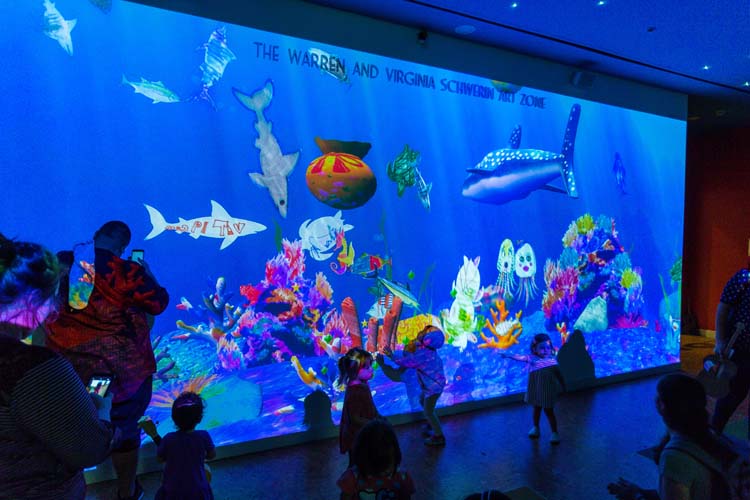
With the official opening of the Art Zone at the Vero Beach Museum of Art held on Jan. 24, a din of children’s chatter and chortles, periodically punctuated by the unmistakable toddlers’ screech, now emanates from what was previously the peaceful Helen Ecclestone Library near the Education Wing. Films are still available at the Helen Ecclestone Stone Film Library located near Visitor Services, but the 672-square-foot space is now a hubbub of children and family activities.
While the museum has always encouraged participation by children and families – its annual Children’s Art Festival began five years before the doors even opened – a hushed ambiance permeated all but the classrooms.
“This space is designed to be multi-sensory; everything is hands on. When kids are in the galleries looking at art, they can’t touch. This is the complete opposite,” says Pam Sommers, Youth and Family Programs manager. “And so we want the children to connect with the art. Just looking at art, and not being able to touch it, is challenging developmentally when they’re at the stage when they need to touch and feel it, and hear and taste it. When it’s interactive they just take to it automatically. They don’t need direction; they just go up to it and start playing with it and they’re learning.”
“So finally we have a dedicated space for our Family Programs. They’ve been growing so rapidly we absolutely needed the space,” said Brady Roberts, VBMA executive director/CEO. “What I love is the diversity. We have all sorts of creative activities they can do related to our special exhibitions and our permanent collection, so it’s just a world of opportunity.”
“So the idea is empowering parents to teach their children about art; of being family-friendly all the time and having a space where it is catering to a child’s developmental needs. The goal is to connect families with art and also inspire creative thinking,” says Sommers, adding that the concept endorses the Moonshot Moment initiative of ‘parents as first teachers.’
Roughly a year and a half in the making, the Art Zone was kick-started with an initial $125,000 grant from the Hearst Foundations. Local philanthropists Warren and Virginia Schwerin gifted a Children’s Education Fund to support Art Zone programs and to fund the delightfully innovative sketch aquarium.
“I think the Museum is one of the legs on which Vero Beach stands and yet there are children who have never been,” said Warren Schwerin. “I think this will improve that immensely. I saw something like this 50 years ago and finally we’ve got an opportunity to do it here.”
From floor to ceiling, the Art Zone was designed to enable children, from babies to age 12, to totally immerse themselves in multi-sensory art experiences and learning. “The idea is to treat it as another gallery, but it’s an interactive gallery rather than just for viewing,” says Sommers.
The pièce de résistance is a colorful 25-foot interactive sketch aquarium wall which uses software to scan children’s drawings, which then float about as creatures in the aquarium. “So once it’s in the aquarium it becomes interactive in the way that children can touch their fish and they can also feed their fish,” says Sommers, noting that ‘food’ comes out by touching a floating bag.
A floor-to-ceiling chalk wall encourages children to express their inner artist with colored chalks. Innovative aroma and soundscape sensory panels let them experience art through smell and hearing – such as pushing a button to get a whiff of fruit in a still life, or listening to animals in a jungle scene. Flexible drawing figures help them imagine the body movements of artistic characters, and a large metal wall contains a plethora of magnets to move about.
“We have one game that’s called ‘play the curator,’ where the children can take pictures from our permanent collection and change them around,” says Sommers. “So the kids can actually get face to face with something they’re going to see in the galleries. They can touch it, they can feel it, they can look at it; and then when they go out into the galleries they’ll have experienced it.”
Every space is utilized, including the ceiling, which projects constellations that children can change at the touch of a switch. “The idea is connecting dots and lines and of course the beginnings of drawing and imaginative storytelling.”
The cork flooring is augmented with colorful carpet tiles that children can pick up and move about to create patterns on the floor. Multi-functional furniture can be flipped and rotated to accommodate different ages and uses.
With flexibility literally built into the endeavor, she can introduce new activities to coincide with rotating exhibitions, such as having little guitars to go along with the Medieval to Metal: The Art & Evolution of the Guitar exhibit.
For more information, visit verobeachmuseum.org.



